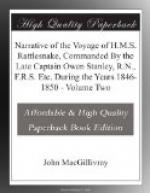(Footnote. Collins’ New South Wales 2nd edition page 10.)
Finding that there was yet some time to spare before the arrival of the usual period for leaving Sydney to pass through Torres Strait, Captain Stanley resolved upon acting in accordance with the expressed wishes of the Colonial Government, that he should make an inspection of the various lighthouses in Bass Strait, and for that purpose sailed from Sydney on February 2nd, with the Rattlesnake and Bramble. The Asp and one of the galleys accompanied us as far as Botany Bay, which they were to be employed in surveying during our absence, under the orders of Lieutenant Simpson.
Bass strait.
On February 8th, we passed between Kent’s and Hogan’s groups (in Bass Strait); the lighthouse on the former of these, perched upon a hill 829 feet high, is admirably situated, and although the night was rather hazy, the light (revolving) shone out with great brilliance, and was afterwards seen from the Bramble’s deck, when thirty-seven miles distant. We caught, in the narrows of the Strait, numbers of baracoudas, a very bold and ravenous fish, and withal a good-eating one, measuring from two to three feet in length; they bite eagerly at a hook towing astern, baited with a piece of red or white rag, and are taken in greatest numbers when several miles distant from the land, and the vessel is going from four to eight knots through the water.
Two days afterwards, the weather being extremely favourable for the purpose, I got several hauls with the dredge in forty-five fathoms, sandy bottom, and, in addition to many curious crustacea and shellfish, a number of very fine zoophytes, almost all of them new to science, were in such abundance as quickly to fill the net.
February 11th.
While standing off and on the land during a fog, a partial clearing up showed the entrance to Port Phillip, with its lighthouse,* and after passing through between the heads, with the usual strong tide ripple, we reached the anchorage at Hobson’s Bay after dark.
(Footnote. Of this Captain Stanley remarks: “In consequence of being placed so far within the heads, the light is visible to seaward only between the bearings of South 1/2 West and South-west 1/2 West. A better position would be on Lonsdale Point, when the light would be seen by vessels coming from the eastward as soon as they rounded Cape Schank. It would also serve as a leading mark for navigating the southern channel, but the tower would require to be of considerable height to show the light over Shortland’s Bluff to vessels inside the harbour.”)




